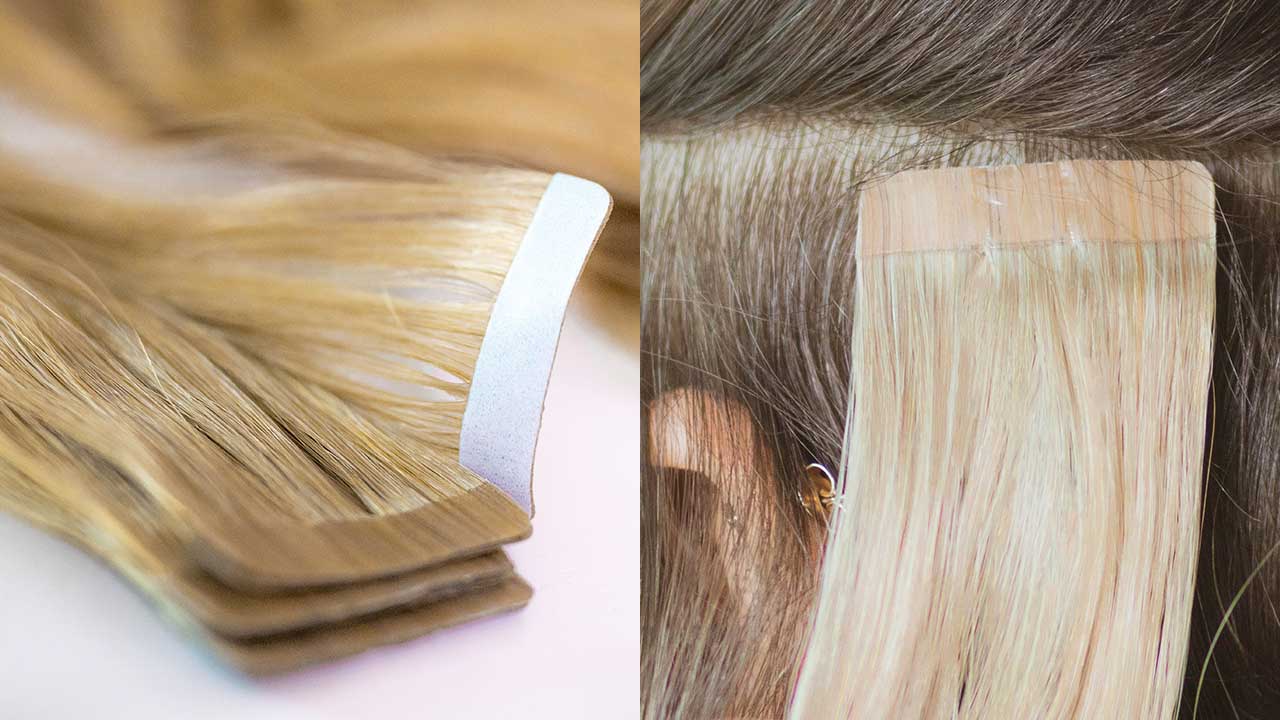Tape-in hair extensions have been around for a while, but would they work for you?
Choosing the right type of hair extensions can sometimes feel overwhelming since there are so many options available and sometimes it’s easiest to just jump on what’s trending. However, taking the time to consider your hair type, lifestyle, and the look you want to achieve will help in picking the best type of hair extensions.
Tape-in hair extensions are usually included in the list of contenders, but they do come with a few pros and cons worth considering. Have questions? We got you, all the details and everything you need to know about tape-in hair extensions are below.

What are tape in hair extensions?
As the name suggests, tape-in extensions come with pre-taped wefts made of a medical-grade adhesive and are usually one inch wide. Similar to other type of hair extensions, tape-ins can be made of real human and Remy hair or synthetic hair. For the most natural look and feel, 100% Remy human hair would be the best choice as the hair cuticle is in tact, the hair is usually collected from one donor, and all the cuticles are facing in the same direction. This allows for less tangles, knots, and matting in the extensions and allows you to style the extensions more freely than with synthetic hair.
How long do tape in extensions last?
Tape-ins are considered semi-permanent extensions. Depending on how they’re cared for and how fast your natural hair grows, tape-in extensions can last around 4-8 weeks before needing to be changed or re-applied.
How are tape in extensions applied?
Tape-in hair extensions should be done by a professional, as they require a few more steps compared to clip-in hair extensions.

After the backing of the adhesive is removed (like a sticker) a thin strip of your natural hair goes in between two strips, so your hair is essentially sandwiched in between the extensions. As the wefts are only an inch wide, it’s important to section the natural hair carefully, which is why a professional hand and eye is recommended, especially when applying tape-ins at the back of the head. As the adhesive base is very thin, tape-ins feel light, lay flat against your head, and blend in easily with natural hair. However, ensure the extensions are distributed evenly in terms of length, volume, and texture around the head for the most natural look.

Applying tape-ins too close to the scalp can make removal difficult and may cause damage as the further the bond is from the root, the more likely it is to get tangled or twisted with your natural hair. It’s also best to leave a bit of room between the adhesive strip and scalp and avoid applying tape-ins near your hairline. After all, you don’t want to reveal your styling secrets!
Tape-ins should be set evenly and straight, aligned with the roots, if applied diagonally it will feel uncomfortable as they may drag and may cause the extension to slip or come out prematurely.

Depending on the length and volume you want to achieve (and in turn, how many extensions you need to get this look) the application process can take anywhere between 45 minutes to an hour and a half. It’s best to do your research and find a hair professional who has experience with tape-in hair extensions. They’ll best be able to give you a time frame for your appointment.
While tape-ins can last for a couple months, switching them up in between is also possible. However, if you’re looking for a more lasting wear out of your tape-ins, ensure the color and texture is a good match to your natural hair.
Removing tape-in hair extensions
Removing tape-in hair extensions also calls for professional help, when scheduling your appointment at the salon for application check in with your stylist to also pre-schedule a removal or re-application service.
A solute is usually used to wet the bonds causing the adhesive to melt or breakdown before the extensions can be gently removed from the hair. Some stylists may also use a spray with alcohol or acetone to dilute the medical-grade glue or adhesive, allowing the weft to be peeled away from the sandwiched hair. Depending on the solution used to remove the glue, a few shampoos will be needed to ensure no residue or glue is left in the hair or on the scalp.
If you’re looking for hair extensions without a chemical process, clip-in hair extensions are the best option as they easily add length and volume that can’t be achieved with natural hair. They can also be easily applied at home and on the go without any chemical products.

Do tape-in hair extensions cause damage?
There’s no denying that correct application can significantly reduce the damage caused by tape-in hair extensions. However, permanent hair extensions varieties will inevitably cause some damage to the hair. Those with thin hair or women who are looking to hide any damage from coloring and other chemical processes may find using just a few tape-ins to add more volume can help achieve a fuller look. Also, because the wefts are only an inch wide and lay flat, the extensions feel lighter and more comfortable. But if they are not applied or cared for properly, this can cause further breakage or damage to the natural hair. Ensure the hair is healthy enough to hold or bond with the adhesive and first-time wearers should do a full inspection after the first removal to check for any damage.
The high-grade adhesive should be considered as well as the solutions used to remove them, as some of these products may contain alcohol or even acetone. These ingredients or products may be harmful to anyone with skin sensitivities. Solutions, sprays, and other products containing alcohol can cause dryness and irritation which may negatively impact the scalp and cuticles of your natural hair. Ensure the scalp is properly hydrated and moisturized especially after the removal of tape-ins, hair masks will also help to prevent any damage from the removal solutions and products.
The biggest mistake people often make is incorrectly applying or removing tape-in hair extensions on their own at home. The application is hard to get right, especially without help and trying to stick or worse, unstick, the extensions can pull and break the hair, causing serious damage.
Caring for tape-in hair extensions

Remy human hair tape-in extensions allow for the same styling versatility as other extensions, meaning you can curl, straighten and even color the extensions darker. While hot styling tools can be used with tape-ins, it’s best to avoid heat near the root or bonds as this will melt or breakdown the adhesive.
It’s also recommended to keep the roots and bonds as dry as possible, this means avoiding washing around these areas as well as investing in a good dry shampoo for no-wash days.
Conditioners and oil-based products aren’t good for tape-ins either as they also interfere with the adhesive’s stickiness, especially if the tape-ins have been worn for a few weeks. Mixing with these products may cause the extensions to slip or come loose so it’s important to look for sulfate-free shampoos and conditioners when washing your hair with tape-ins.
Avoiding friction with the bonds is also essential in keeping tape-ins in tact. As tape-in extensions cannot be removed and stored at the end of the day like clip-in extensions, for example, professionals recommend loosely clipping up the hair or putting it in a loose braid at night before bed.
Brushing the tape-in extensions frequently is also recommended. Make sure to do so using a Loop Hair Extensions Brush or other hairbrush designed for hair extensions to ensure it will glide through the natural hair and extensions seamlessly without tugging. Be sure to avoid brushing from the root or bond and don’t brush the hair when wet as the hair is more vulnerable and prone to breakage.
How much do tape-in hair extensions cost?
Depending on how many wefts you need to complete your look, tape-in hair extensions can cost anywhere between $200-$800. This will also depend on whether you choose Remy hair extensions or synthetic, the latter being the cheaper option. When budgeting for tape-in hair extensions remember to consider the cost of having a professional apply and remove them for you.
So, who should wear tape-in hair extensions?
Tape-in hair extensions are worth considering if you’re willing to commit to professional application and removal. However, they can cause considerable damage to your hair, so you may find yourself in an endless cycle of trying to grow out your hair and finding it is perpetually damaged due to the tape-in hair extensions. It’s important to see a professional with experience applying and removing tape-ins to ensure the damage is as minimal as possible.

Also, as tape-ins don’t need to be applied and reapplied frequently, they are definitely a time-saver for the girl on the go. They can still be straightened or curled when needed and they can even be reused after removal if they are in good condition.
Other options such as clip-in extensions can be applied and removed safely daily, allowing for more versatility in styles, lengths and color, tape-ins should remain on for a few weeks to get the most out of their wear.
Written by: Rosalyn Solomon








